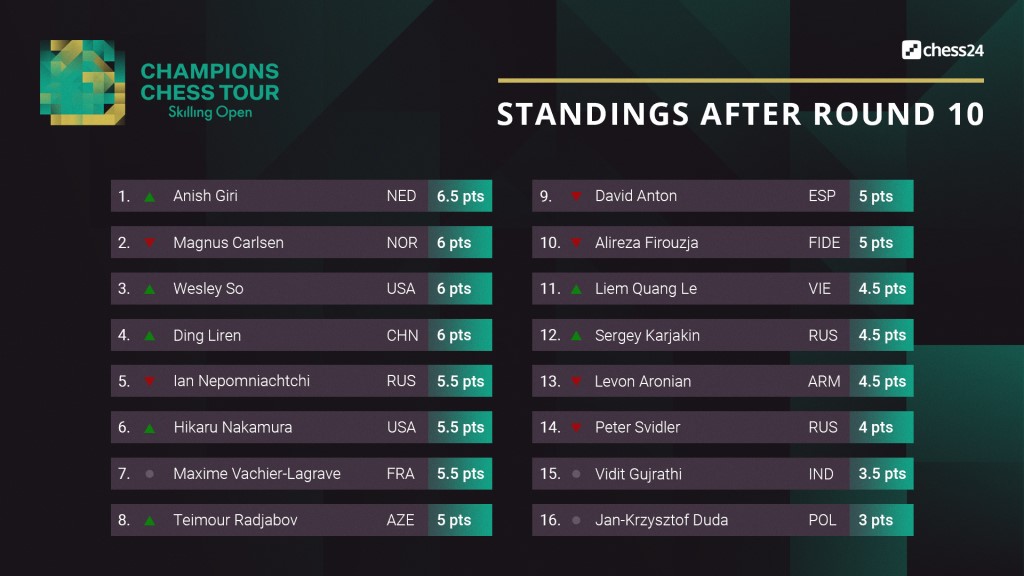


One of the attractive features of the format used in the Champions Chess Tour is the fact that advancing to the knockout stage is a tough task even for some of the strongest players in the world. With the likes of lower-rated players absolutely capable to upset the big stars at any point in time, the fight to stay alive is a fun spectacle before the direct matchups start on the fourth day of competition.
David Antón, Le Quang Liem and, of course, the youngster Alireza Firouzja have picked up wins over the big guns throughout. However, in a long 15-round all-play-all, consistency is what matters most. After all, the standings table has all 2800+ players among the top 8, joined by four regulars of the elite circuit — Anish Giri, Wesley So, Ian Nepomniachtchi and Teimour Radjabov.
Notice, though, that the likes of Levon Aronian, Sergey Karjakin and Peter Svidler will need to have a good run on day 3 to reach the quarterfinals.
With the new tour granting points not only to those moving on to the knockout stage, fighting for first in the round robin is not only a matter of pride. Currently, Giri is atop the standings on 6½/10 after winning three times and drawing the remainder of his games. Magnus Carlsen, Wesley So and Ding Liren stand a half point back.

Click to enlarge
Eight games per round, with five rounds per day, surely provide plenty of interesting battles, good-looking combinations and missed opportunities. In round 6, for example, Nakamura did not foresee a tactical shot in his game against Le:
White is still fine after 29...Rxb5 30.Nxb5 Qxb2, but the game-losing blunder came after 31.Bxd5 Bxd5:
32.Nxc7 allowed Black to play the stunning 32...Rxe3, attacking the queen — the only piece defending the mate on g2. (Note that 33.Rxe3 fails to 33...Qc1+ attacking the knight). Nakamura was visibly upset, and tried to defend his losing position after 33.Nxd5 Rxg3+ 34.hxg3 Qd4 35.Ne3, but to no avail. Resignation came on move 46.

It was a great start of the day for the Vietnamese, who had to face Maxime Vachier-Lagrave’s Najdorf Sicilian in the very next round:
A typical double-edged Najdorf! And now Vachier-Lagrave showed why he is considered perhaps the biggest specialist in these systems — 19...Rxc3 and there is no way back. The game continued 20.gxf6 Rb8 21.Nb3 Rxb3 (insisting on the exchange sacrifice) 22.cxb3 Qxe4+:
Here is where White faltered decisively with 23.Ka1, allowing the Frenchman to place his dark-squared bishop on the all-important long diagonal with 23...Bxf6. Better for White was 23.Bd3 Nxd3 24.Qxd3 Qxf4 25.Rhf1 (preventing ...Bf5+) Qh4 and 26.fxe7, when the king on b1 is still in danger, but Black will need to work harder to break through.
After the text, Le quickly found himself forced to resign after 24.Bg2 Nf3 25.Qe3 Qc2:
0-1. It takes courage to face MVL in the Najdorf!

Going into the last round of day 2, Carlsen was sharing the lead with Giri on 5½ points. Giri drew Radjabov with white, but anyway ended up in the sole lead for a second day in a row, as the world champion lost against Karjakin in round 10:
The Russian, playing white, has advanced his kingside pawns and closed the structure on that flank of the board. With Black’s position cramped on that side, White is threatening to trap the queen via Bh3. The double-edged battle continued — 27...c5 28.Be3 d4 29.Bh3 dxe3 30.Qg3:
There is no way to save the black queen, thus 30...Qxc2 31.Rxc2 Nxc2 32.f5. The engines think Black is okay still, but finding the correct moves in such a sharp position is never easy, especially in a rapid game — even for the world champion. Black faltered with 32...Rd2+:
Black needed to play 32...Ned4 consolidating his position and putting the pressure on White, who would have needed to find a plan to make progress. After the text, however, there followed 33.Kh1 gxf5 34.Bxf5 and the move that probably Carlsen counted on from the beginning of the variation — 34...e2:
The problem is that after 35.Nxe2 Rxe2 36.Bxe6 Rxe6, White has 37.Qf3 with a double attack on the rook and the weak spot on f7:
White is totally winning. Carlsen continued playing until move 52, but Karjakin did not falter until getting his second win of the event.
